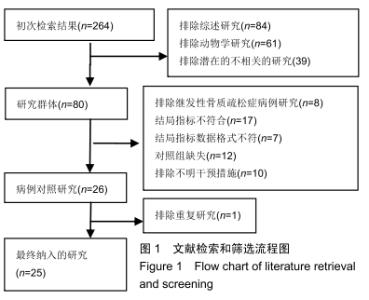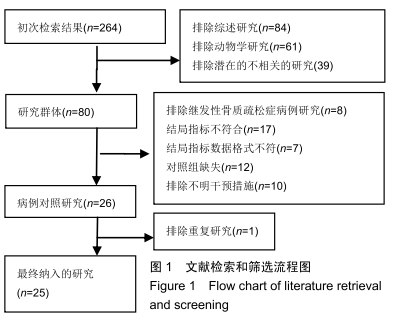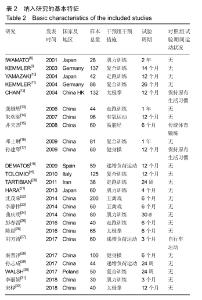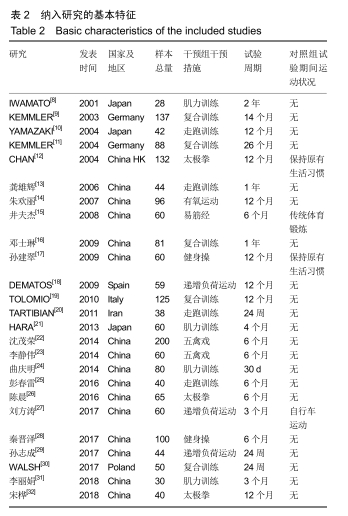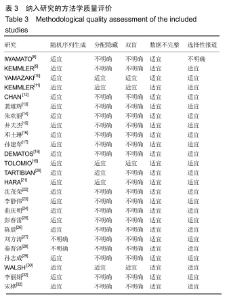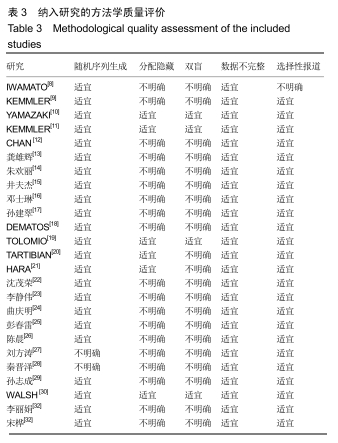Chinese Journal of Tissue Engineering Research ›› 2020, Vol. 24 ›› Issue (17): 2782-2788.doi: 10.3969/j.issn.2095-4344.2574
Meta-analysis of bone metabolism indicators in patients with primary osteoporosis under different forms of exercises
Yuan Qiubao, Kong Haijun
- Kashgar University Sports School, Kashar 844006, Xinjiang Uygur Autonomous Region, China
-
Received:2018-12-21Revised:2019-01-02Accepted:2019-04-15Online:2020-06-18Published:2020-03-30 -
About author:Yuan Qiubao, Master, Lecturer, Kashgar University Sports School, Kashar 844006, Xinjiang Uygur Autonomous Region, China
CLC Number:
Cite this article
Yuan Qiubao, Kong Haijun. Meta-analysis of bone metabolism indicators in patients with primary osteoporosis under different forms of exercises [J]. Chinese Journal of Tissue Engineering Research, 2020, 24(17): 2782-2788.
share this article
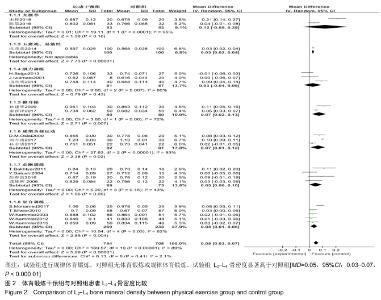
2.3 Meta分析结果 2.3.1 骨密度 L2-L4骨密度共纳入20组随机对照试验研究[8-15,17-22,24-29,32]。Meta分析森林图显示,体育锻炼干预组与对照组比较,纳入研究结果间存在高异质性(I2=89%,P < 0.000 01),故采用随机效应模型进行分析,见图2。结果显示,体育锻炼干预组较对照组骨密度水平出现显著上升(MD=0.05,95%CI:0.03-0.07),且差异有显著性意义(P < 0.000 01)。亚组分析显示,健身操(MD=0.07,95%CI:0.02-0.13)、五禽戏-易筋经(MD=0.03,95%CI:0.02-0.04)、递增负荷训练(MD=0.07,95%CI:0.01-0.12)及复合训练(MD=0.04,95%CI:0.01-0.06)均可显著提高骨质疏松症患者L2-L4骨密度水平,合并效应量差异均有显著性意义(P < 0.05);太极拳、肌力训练及走跑训练可提高骨质疏松症患者L2-L4骨密度水平,但运动干预组与对照组比较差异无显著性意义(P > 0.05)。Egger’s及Begg’s检验结果显示,Egger’s检验结果,t=0.72,P=0.33;Begg’s检验结果,Kendall’tau=0.54,P=0.26,差异均无显著性意义,提示此次研究纳入资料不存在发表偏倚。 "
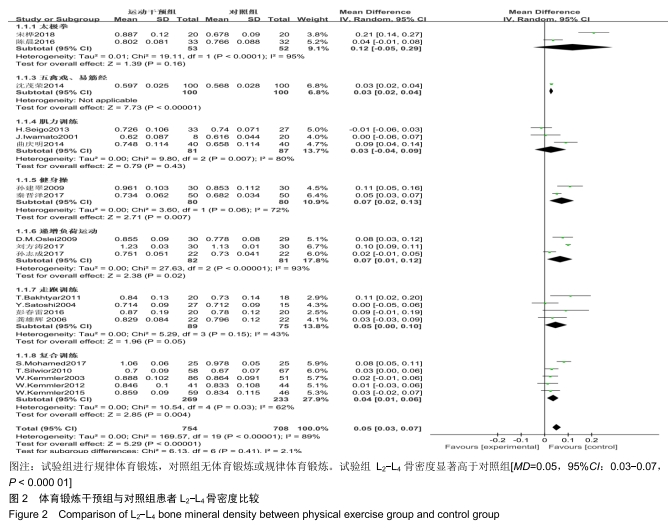
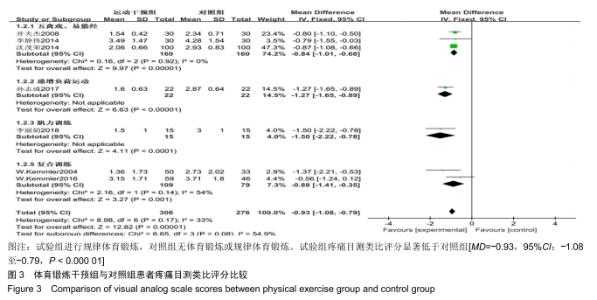
2.3.2 疼痛目测类比评分 疼痛目测类比评分共纳入7组随机对照试验研究[11,15-16,22-23,29,31]。Meta分析森林图显示,体育锻炼干预组与对照组比较,纳入研究结果间存在低异质性(I2=33%,P=0.17),故采用固定效应模型进行分析,见图3。Meta分析结果显示,体育锻炼干预可显著降低骨质疏松症患者疼痛目测类比评分(MD=-0.93,95%CI:-1.08至-0.79),且差异有显著性意义(P < 0.000 01)。Egger’s及Begg’s检验结果显示,Egger’s检验结果,t=-0.79,P=0.43;Begg’s检验结果,Kendall’ tau=0.37,P=0.31,差异均无显著性意义,提示本研究纳入资料不存在发表偏倚。 "
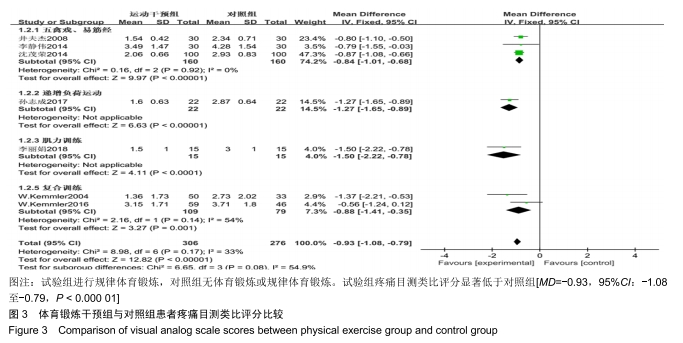

2.3.3 骨代谢指标 此次研究中骨代谢的结局指标包括骨钙素、总Ⅰ型胶原氨基端延长肽、尿吡啶啉/肌酐、血钙及血磷。Meta分析森林图显示,体育锻炼组与对照组比较,骨钙素、总Ⅰ型胶原氨基端延长肽、尿吡啶啉/肌酐纳入研究结果间存在高异质性(I2=100%,P < 0.000 01;I2=90%,P < 0.000 1;I2=100%,P < 0.000 01),故采用随机效应模型进行分析;血钙及血磷纳入研究结果间异质性较低(I2=0%,P=0.48;I2=0%,P=0.46),故采用固定效应模型进行分析。Meta分析结果显示,体育锻炼干预可提高骨质疏松症患者血清骨钙素、总Ⅰ型胶原氨基端延长肽及血磷水平(MD=0.83,95%CI:-1.96-3.62;MD=10.28,95%CI:-1.44-21.99;MD=0.02,95%CI:0.00-0.04),并降低尿吡啶啉/肌酐(MD=-6.96,95%CI:-21.13-7.22)及血钙水平(MD=-0.02,95%CI:-0.04-0.00),但差异均无显著性意义(P > 0.05),见图4-8。纳入研究总体不存在发表偏倚。 "

| [1] HENNEMANN A. Osteoporosis: prevention, diagnosis and therapy. Medizinische Monatsschrift Für Pharmazeuten. 2002; 25(5):164. [2] PIETSCHMANN P, MECHTCHERIAKOVA D, MESHCHERYAKOVA A, et al. Immunology of osteoporosis: a mini-review. Gerontology. 2016; 62(2):128-137. [3] 中华医学会骨质疏松和骨矿盐疾病分会. 原发性骨质疏松症诊疗指南(2017)[J].中华骨质疏松和骨矿盐疾病杂志,2017,20(5): 413-443. [4] HARDING A, BECK B. Exercise, osteoporosis, and bone geometry. Sports. 2017;5(2):29. [5] PARK KS, YOO JI, KIM HY, et al. Education and exercise program improves osteoporosis knowledge and changes calcium and vitamin D dietary intake in community dwelling elderly. BMC Public Health. 2017;17(1):966. [6] 邹永.运动防治社区老年骨质疏松研究进展[J].现代诊断与治疗, 2019,30(4):535-538. [7] LUCATO P, TREVISAN C, STUBBS B, et al. Nephrolithiasis, bone mineral density, osteoporosis, and fractures: a systematic review and comparative meta-analysis. Osteoporos Int. 2016;27(11):3155-3164. [8] IWAMOTO J, TAKEDA T, ICHIMURA S. Effect of menatetrenone on bone mineral density and incidence of vertebral fractures in postmenopausal women with osteoporosis: a comparison with the effect of etidronate. J Orthop Sci. 2001; 6(6):487-492. [9] KEMMLER W, ENGELKE K, WEINECK J, et al. The erlangen fitness osteoporosis prevention study: a controlled exercise trial in early postmenopausal women with low bone density-first-year results. Arch Phys Med Rehabil. 2003; 84(5):673-682. [10] YAMAZAKI S, ICHIMURA S, IWAMOTO J, et al. Effect of walking exercise on bone metabolism in postmenopausal women with osteopenia/osteoporosis. J Bone Miner Metab. 2004;22(5):500-508. [11] KEMMLER W, LAUBER D, WEINECK J, et al. Benefits of 2 years of intense exercise on bone density, physical fitness, and blood lipids in early postmenopausal osteopenic women: results of the Erlangen Fitness Osteoporosis Prevention Study (EFOPS). Arch Int Med. 2004;164(10):1084-1091. [12] CHAN K, QIN L, LAU M, et al. A randomized, prospective study of the effects of Tai Chi Chun exercise on bone mineral density in postmenopausal women. Arch Phys Med Rehabil. 2004;85(5):717-722. [13] 龚雄辉,闫福芝,张红霞.登山对绝经后骨质疏松症患者骨量的影响[J].现代中西医结合杂志,2006,15(19):2611-2612. [14] 朱欢丽,刘晓晴,夏秦.运动对老年骨质疏松症患者骨量和骨代谢影响的研究[J].中国妇幼保健,2007,22(9):1251-1252. [15] 井夫杰,张静.易筋经锻炼对原发性骨质疏松症患者骨密度的影响[J].中国体育科技,2008,44(2):88-90. [16] 邓士琳.体力活动与绝经后骨质疏松症的关系及运动干预模式的研究[J].中国体育科技,2009,45(6):118-126. [17] 孙建翠,崔西泉.有氧健身运动对老年性骨质疏松的影响[J]. 中国矫形外科杂志,2009,17(17):1326-1328. [18] DE MATOS O, LOPES DA SILVA DJ, MARTINEZ DE, et al. Effect of specific exercise training on bone mineral density in women with postmenopausal osteopenia or osteoporosis. Gynecol Endocrinol. 2009;25(9):616-620. [19] TOLOMIO S, ERMOLAO A, LALLI A, et al. The effect of a multicomponent dual-modality exercise program targeting osteoporosis on bone health status and physical function capacity of postmenopausal women. J Women Aging. 2010; 22(4):241-254. [20] TARTIBIAN B, MALEKI BH, KANALEY J, et al. Long-term aerobic exercise and omega-3 supplementation modulate osteoporosis through inflammatory mechanisms in post-menopausal women: a randomized, repeated measures study. Nutr Metab (Lond). 2011;8:71. [21] HARA S, KISHIMOTO KN, OKUNO H, et al. Effects of alfacalcidol on back extensor strength gained through back extensor exercise in postmenopausal women with osteoporosis. Am J Phys Med Rehabil. 2013; 92(2):101-110. [22] 沈茂荣,冯彦江,韦文武,等.华佗五禽戏锻炼对老年性骨质疏松患者骨代谢的影响[J].中华中医药杂志,2014,29(3):895-897. [23] 李静伟,潘定权,何康宏,等.五禽戏防治原发性骨质疏松症的研究探讨[J].中国骨质疏松杂志,2014,20(7):849-853. [24] 曲庆明.核心肌力训练对骨质疏松患者骨密度的影响[J].医学信息, 2014, 36(4):306-307. [25] 彭春雷,钱志远,温仲民.不同程度有氧运动对绝经后骨质疏松患者骨密度和雌激素水平影响的研究[J].中国血液流变学杂志, 2016, 26(1):101-103. [26] 陈晨.运动疗法对绝经后骨质疏松症骨密度、瘦体重、脂肪含量的影响[D].南京:南京中医药大学,2016. [27] 刘方涛,闫巧珍.递增负荷功率自行车运动对骨质疏松患者骨密度的影响[J].中国骨质疏松杂志,2017,23(4):456-458. [28] 秦晋泽,荣晓旭,朱国兴,等.广场舞对绝经期后骨质疏松患者的骨密度和骨转换指标影响的研究[J].中国骨质疏松杂志,2017, 23(1):43-46. [29] 孙志成,欧阳钢,顾晓美,等. 核心力量训练对绝经后骨质疏松症患者跌倒风险相关因素及骨密度的影响[J]. 河北医科大学学报, 2017, 38(11):1300-1304. [30] ALAYAT MSM, ABDELKAFY EM, ELSOUDANY AM, et al. Efficacy of high intensity laser therapy in the treatment of male withosteopenia or osteoporosis: a randomized placebo-controlled trial. J Phys Ther Sci. 2017;29(9):1675. [31] 李丽娟,别明波,张宗欣,等.渐进性抗阻训练对绝经后骨质疏松患者骨密度及骨代谢标记物的影响[J].中国骨与关节杂志, 2018, 7(1):77-80. [32] 宋桦.太极拳锻炼对原发性骨质疏松症患者骨密度及骨代谢的影响[J]. 体育学刊, 2008, 15(11):106-108. [33] EKNOYAN G, LEVIN A, LEVIN NW. Bone metabolism and disease in chronic kidney disease. Am J Kidney Dis. 2003; 42(3):1-201. [34] WALSH MC, KIM N, KADONO Y, et al. Osteoimmunology: interplay between the immune system and bone metabolism. Ann Rev Immunol. 2006;24(24):33-63. [35] 童迪夷,梁兴伦,赵雁.适合中国国情的中老年骨质疏松症防治六原则[J].中国全科医学,2017,20(12):1403-1409. |
| [1] | Huang Dengcheng, Wang Zhike, Cao Xuewei. Comparison of the short-term efficacy of extracorporeal shock wave therapy for middle-aged and elderly knee osteoarthritis: a meta-analysis [J]. Chinese Journal of Tissue Engineering Research, 2021, 25(9): 1471-1476. |
| [2] | Li Dadi, Zhu Liang, Zheng Li, Zhao Fengchao. Correlation of total knee arthroplasty efficacy with satisfaction and personality characteristics [J]. Chinese Journal of Tissue Engineering Research, 2021, 25(9): 1346-1350. |
| [3] | Wei Wei, Li Jian, Huang Linhai, Lan Mindong, Lu Xianwei, Huang Shaodong. Factors affecting fall fear in the first movement of elderly patients after total knee or hip arthroplasty [J]. Chinese Journal of Tissue Engineering Research, 2021, 25(9): 1351-1355. |
| [4] | Lü Zhen, Bai Jinzhu. A prospective study on the application of staged lumbar motion chain rehabilitation based on McKenzie’s technique after lumbar percutaneous transforaminal endoscopic discectomy [J]. Chinese Journal of Tissue Engineering Research, 2021, 25(9): 1398-1403. |
| [5] | Gao Yan, Zhao Licong, Zhao Hongzeng, Zhu Yuanyuan, Li Jie, Sang Deen. Alteration of low frequency fluctuation amplitude at brain-resting state in patients with chronic discogenic low back pain [J]. Chinese Journal of Tissue Engineering Research, 2021, 25(8): 1160-1165. |
| [6] | Chen Jiming, Wu Xiaojing, Liu Tianfeng, Chen Haicong, Huang Chengshuo. Effects of silymarin on liver injury and bone metabolism induced by carbon tetrachloride in mice [J]. Chinese Journal of Tissue Engineering Research, 2021, 25(8): 1224-1228. |
| [7] | Zhao Zhongyi, Li Yongzhen, Chen Feng, Ji Aiyu. Comparison of total knee arthroplasty and unicompartmental knee arthroplasty in treatment of traumatic osteoarthritis [J]. Chinese Journal of Tissue Engineering Research, 2021, 25(6): 854-859. |
| [8] | Zhang Nianjun, Chen Ru. Analgesic effect of cocktail therapy combined with femoral nerve block on total knee arthroplasty [J]. Chinese Journal of Tissue Engineering Research, 2021, 25(6): 866-872. |
| [9] | Wu Gang, Chen Jianwen, Wang Shilong, Duan Xiaoran, Liu Haijun, Dong Jianfeng. Simple HyProCure subtalar stabilization in treatment of adolescent flexible flatfoot combined with painful accessory navicular bone [J]. Chinese Journal of Tissue Engineering Research, 2021, 25(6): 901-905. |
| [10] | Li Yan, Wang Pei, Deng Donghuan, Yan Wei, Li Lei, Jiang Hongjiang. Electroacupuncture for pain control after total knee arthroplasty: a meta-analysis [J]. Chinese Journal of Tissue Engineering Research, 2021, 25(6): 957-963. |
| [11] | Zheng Xiaolong, He Xiaoming, Gong Shuidi, Pang Fengxiang, Yang Fan, He Wei, Liu Shaojun, Wei Qiushi. Bone turnover characteristics in patients with alcohol-induced osteonecrosis of the femoral head [J]. Chinese Journal of Tissue Engineering Research, 2021, 25(5): 657-661. |
| [12] | Li Quanxi, Shen Yu, Wan Wei, Sun Shanzhi. Changes of abdominal wall mechanics and pain after tension-free inguinal hernia repair with polypropylene mesh [J]. Chinese Journal of Tissue Engineering Research, 2021, 25(4): 548-552. |
| [13] | Wang Xiaofei, Teng Xueren, Cong Linyan, Zhou Xu, Ma Zhenhua. Herbert screw internal fixation for treating adult osteochondritis dissecans of the knees [J]. Chinese Journal of Tissue Engineering Research, 2021, 25(3): 397-402. |
| [14] | Yang Wei, Chen Zehua, Yi Zhiyong, Huang Xudong, Han Qingmin, Zhang Ronghua. Effectiveness of intra-articular injection of hyaluronic acid versus placebo in the treatment of early and mid-stage knee osteoarthritis: a Meta-analysis based on randomized, double-blind, controlled, clinical trials [J]. Chinese Journal of Tissue Engineering Research, 2021, 25(23): 3760-3766. |
| [15] | Liu Chang, Li Datong, Liu Yuan, Kong Lingbo, Guo Rui, Yang Lixue, Hao Dingjun, He Baorong. Poor efficacy after vertebral augmentation surgery of acute symptomatic thoracolumbar osteoporotic compression fracture: relationship with bone cement, bone mineral density, and adjacent fractures [J]. Chinese Journal of Tissue Engineering Research, 2021, 25(22): 3510-3516. |
| Viewed | ||||||
|
Full text |
|
|||||
|
Abstract |
|
|||||
